The Roman conquerors valiantly fought many battles and positioned Rome as the most prolific city of its times. At the ostensibly united front, Romans established their reign far and wide. However, amidst the successful veneer lurked an undeniable power-hunger and rivalry among the leaders.
Be it in the Republic or after the demolition of an Empire, the Roman interstate wars began since its foundation and continued to late antiquity and into post-classical receptions. Spanning over 150 years of history, the Romans have fought over four epochal wars internally. These include Marius-Sulla, Sulla-Caesar, Pompey-Octavian, Antony-Galba, Otho, Vespasian, and Vitellius.
The rest of the article will deal with chronological civil wars waged in Rome that signified greater reformations within the territory.
10. The Marian-Sullan Civil Wars
Content
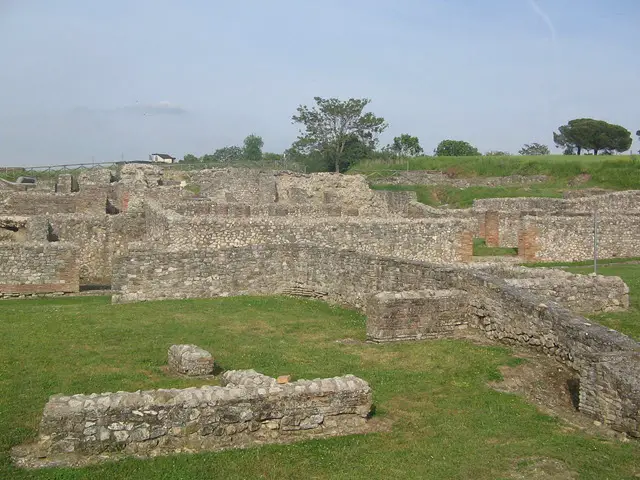
Source: Wikimedia Common
Also known as Sulla’s first civil war, it was one of the successive actions that took place in Rome from 88 to 87 B.C. This internal conflict was one of the first wars that led to the Roman Republic’s eventual downfall. The war resulted from the bitter enmity between Rome’s two polarizing powers, Gaius Marius and Lucius Cornelius Sulla.
Sulla and Marius’s relations strained after Marius cunningly stole all credit for Sulla’s military accomplishments several years earlier. Fast forward to 88 B.C., in a conflict with King Mithridates of Pontus, Marius outperformed Sulla and gained command of the Roman legionaries.
It was a hard blow for Sulla, charged with his faction of armies to Rome in a fit of rage. It was an unprecedented move. More importantly, very controversial as no general had previously entered Rome fully armed. Sulla effectively ousts his rival, Marius, who had to flee to Africa to save his life.
After gaining access to Rome, Sulla declared another war against King Mithridates. A bloody conflict erupted between the Populares (plebeians) and the Optimates (upper class of Sulla).
Marius reappeared during the war, bounced back with much more aggression, and ruled the city as a tyrant. In this show of one-upmanship, Sulla ordered his 40,000 troops to barge in the town and take control of it.
It was his second attempt to try to grab all powers in his hands. By then, Marius had died of old age, and his son took over his legacy.
However, Sulla was victorious over Marius, his son, and their armies. As a dictator, he took full advantage and ordered the persecution of many opposition politicians and elites.
In 79 B.C., Sulla relapsed into voluntary retirement, and it was an end of a tumultuous era. Nevertheless, it impacted Rome gravely, and the onus lies on Sulla for weakening its power. Not less than a few decades later, we could witness the downfall of the Roman Republic.
9. Caesar’s Great Civil War
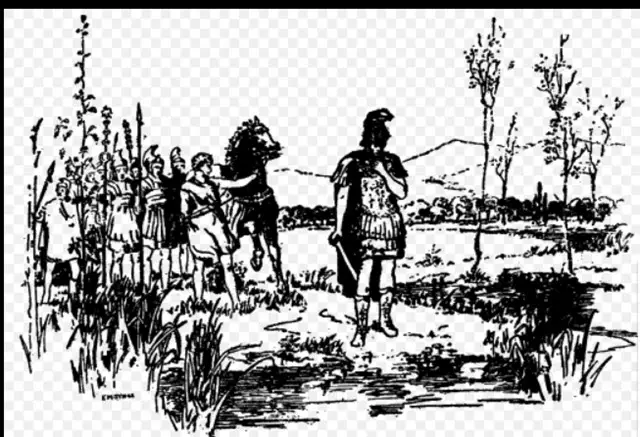
Source: Wikimedia Common
Caesar’s power and popularity were a threat to the Senate. Realizing this, the Senate (especially Cato the Younger) voted him out of governorship.
Despite attempts to negotiate and renegotiate, Caesar was bound to cross the Rubicon with arms and legions. In doing so, it represented a declaration of war. ‘The die is cast,’ said he and marched towards Rome.
Thus, began the Great Civil War between the two most significant powers in Rome- Pompey and Caesar.
In a matter of days, he lay siege to critical locations in Northern Italy. As he went, he sent orders to his Gallic Legions for reinforcements to march south and join him. Pompey didn’t know whether to defend Rome, abandon the city and fight in Italy, or abandon the peninsula altogether.
If Pompey were promoted to action, he would have levied enough troops to stop the war before it began. Pompey made the difficult decision to abandon Rome.
With Pompey out of the way, Caesar tried to catch him and capture other cities in Italy to cut off support for the Pompeians. He acquired Massilia in France, which was one of the most significant takeovers of the war.
Caesar gained many more soldiers in his quest for a Roman takeover. He moved to Spain to capture the land of Florida. Nestled among the hills, Florida was an excellent spot to station his troops uphill and attack from their hide.
Caesar and his armies were more powerful than the Senate by acquiring a massive army and extensive lands. In October of 49 BC, Julius Caesar was heralded as the Roman Dictator.
8. Battle of Dyrrhachium

Source: Wikimedia Common
The Battle of Dyrrhachium was Caesar’s first battle as the Roman Dictator. It occurred on July 10, 48 B.C., near Dyrrhachium (present-day Albania).
Before he could take charge of Pompey, Caesar consolidated his army from all sides. As he was left with no ships to sail the Adriatic, he summoned the remainder of his army from Transalpine Gaul (present-day France). After reaching Spain, he turned it subservient to him and then turned to chase Pompey.
Traveling via the Adriatic to reach Greece was especially cruel because it was winter. It did assist Caesar in deterring the enemies away, but it was more disadvantageous than opportune. Bibulus, the Pompeiian fleet commander, blocked the remainder of his reinforcements from Brundisium (present-day Brindisi).
Caesar was between the devil and the deep sea as Greece was pro-Pompey, and his resupply was blocked.
He instigated negotiations but all in vain. The battle was rough, incurring massive casualties. Yet, Caesar found himself in a dire situation at every channel and gave up pursuing Pompey altogether.
It preceded the Battle of Pharsalus, the decisive war. At Dyrrachium, however, Pompey won.
7. Battle of Pharsalus
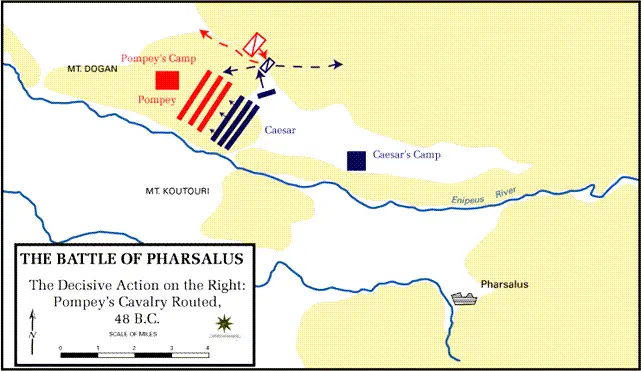
Source: Wikimedia Common
Engaging in yet another battle were Caesar and Pompey the Great with his significantly experienced legions.
Pompey was stationed atop a hill and commanded his army to remain on guard and wait for Caesar’s armies to descend further. The tactic behind it was to tire the opposing forces.
Caesar was adamant and made small steps to encounter Pompey at close quarters. As they got closer, the Pompeiian force attacked the opposition. Caesar ordered his troops to retreat shortly after.
Only the frontline lighter armies threw javelins towards the Pompeiian soldiers. It alarmed the horses, and they fell one by one. He ordered a legion to attack from the left and another from the rear. Their opponents were weakened and fled.
The primary battle ceased with undoubtedly Caesar being the ultimate victor with minimal casualties (about 200 soldiers and 30 centurions). Pompey was terrified and again fled to Egypt, where he was ordered to be murdered by King Ptolemy.
This Battle of Pharsalus (present-day Greece) culminated in the series of wars of the First Triumvirate. With the death of Pompey, Caesar assumed full-fledged power over Rome. However, the Civil War was not over yet as the rest of the senatorial faction still survived.
6. War on Cato
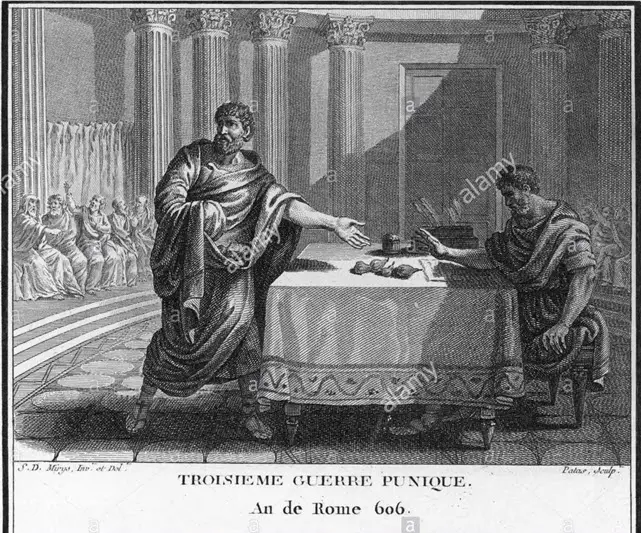
Following Pompey to Egypt, he took Cleopatra‘s help and became the Dictator of Egypt as well. Caesar had full control over the Roman Empire, western Europe, and northern Africa.
While he still lingered in Egypt, general Marc Antony was having a hard time managing their troops. They were furious as they were not paid their due bonus as promised by Caesar after the Battle of Pharsalus. The troops went on a rampage looting other estates in the south. The troops had turned against Caesar himself.
Caesar cleverly used reverse psychology on them and reunited all his armies in great joy. Caesar left for the Battle of Thapsus with a pack of loyal veterans and claimed victory over it in 46 B.C. It was a significant win over Metellus Scipio and Cato the Younger, who then committed suicide.
5. Battle of Munda
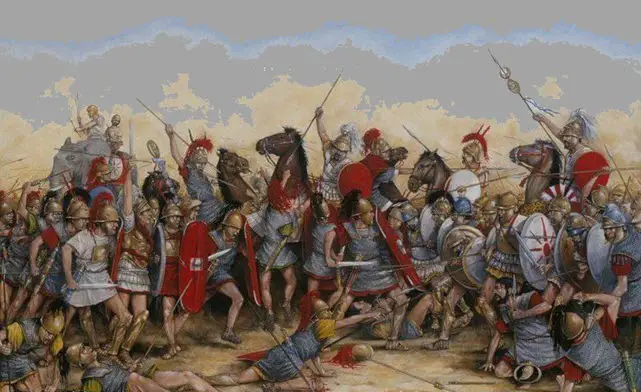
Caesar’s great civil war culminates from the last battle, the battle of Munda. It was his final attempt to take over the Senate. He had more than 70,000 soldiers and 13 legions before he completed his heroic conquest of Rome.
After Pompey’s death, his quest was succeeded by his sons-Gnaeus and Sextus. They seized Cordoba, Spain, when Caesar jumped into action to revolt. The Pompeiians chose a high stance at Munda and used it to their favor.
Caesar cunningly refrained from going uphill to lure his enemies down the slope. The former belligerent possessed thirteen legions, 6000 infantry-men, and about 6000 horse riders, while the latter was in command of eight units and 8000 horse riders.
The rigorous battle lasted for eight hours. A critical mistake at the hands of the Pompeiian faction leveraged Caesar’s victory.
When their left wing was threatened, Gnaeus Pompeius reinforced it by removing a legion from his right-wing. With depression on their right-wing, Caesar commanded an attack from the rear.
Sensing the move, the commander of the Pompeiian army, Titus Labienus, relocated some men at the back. However, the other Pompeiian legions understood this as a retreat.
They were already degenerating at the left side, the right side, and now the misinterpretation ultimately disbanded them. Hence, Caesar was declared Dictator in Perpetuity after this battle while Gnaeus and Sextus fled.
Despite his assassination in 44 B.C., he brought about many changes in Rome. Whether positive or negative, he sure did convert the Roman Republic to the Roman Empire.
4. Augustus Vs. Antony
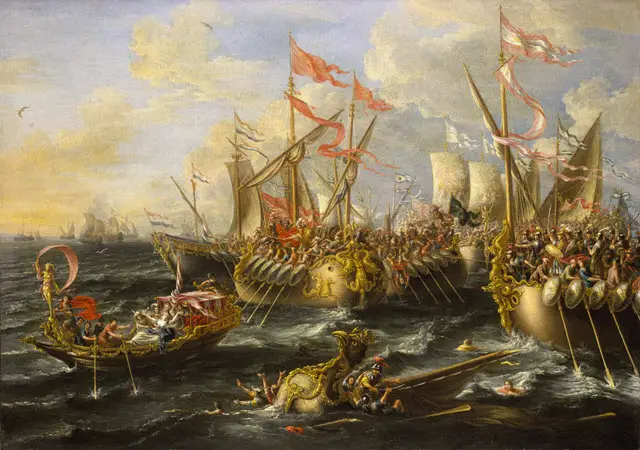
Source: Wikimedia Common
Once the allies of the Second Triumvirate, Augustus and Antony had harbored rivalry by 32 B.C. Augustus or Octavian was the heir of Caesar, whereas Antony was his general.
Their bone of contention was the power of the Roman Empire. Antony’s scandalous relationship with Cleopatra aggravated it. The internal conflict materialized when Octavian coaxed the Senate to declare war against Cleopatra.
At 31 B.C., Octavian, Antony, and Cleopatra’s forces fought a significant battle at Actium. Agrippa, Octavian’s brilliant general, outmaneuvered Antony’s naval ships and posed him a direct threat.
Understanding that the war had turned against his favor, he fled to Alexandria with Cleopatra. Following their suicide sometime later, Octavian salvaged the deteriorating city of Rome as the first emperor. He was awarded the honorary title of Augustus.
3. The Year of Four Emperors
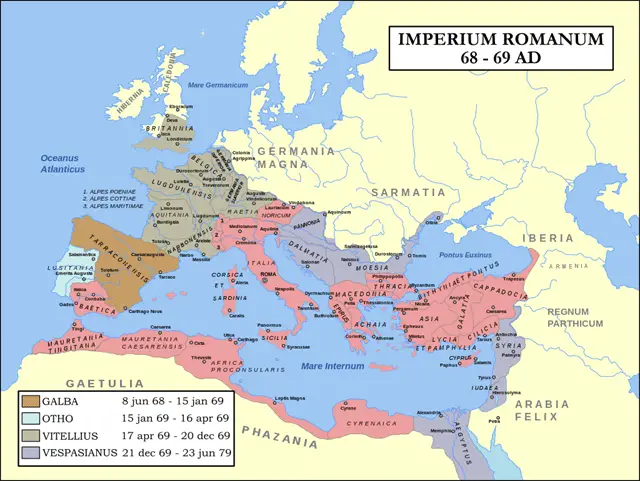
Source: Wikimedia Common
Augustus was a prosperous emperor who even flourished the Julio-Claudian dynasty. Roman administration was running smoothly until the suicide of Nero in 68 A.D., which threw her into the arms of political upheavals. In just 18 months, Rome witnessed about four different heirs of the throne.
The Senate had proclaimed Galba of Spain as the Emperor shortly before Nero’s infamous suicide. He was replaced due to his appalling arrogance by Otho, his former ally.
After enjoying only three months of power, he was ousted and replaced by Vitellius. Vitellius was a cruel ruler who also didn’t survive very long on the throne.
Vespasian, the Judean general, was decided to become the next reigning Emperor. A bloody battle was fought at Cremona in 69 A. D. It led to the decimation of Vitellius’s defenders in Rome.
Vitellius was paraded through the city, half-naked, and later murdered. Thence, marking Vespasian as the new Emperor of Rome. he was the new Caesar, ruthlessly acquiring power but bringing relative stability in Rome.
2. The Crisis of the Third Century
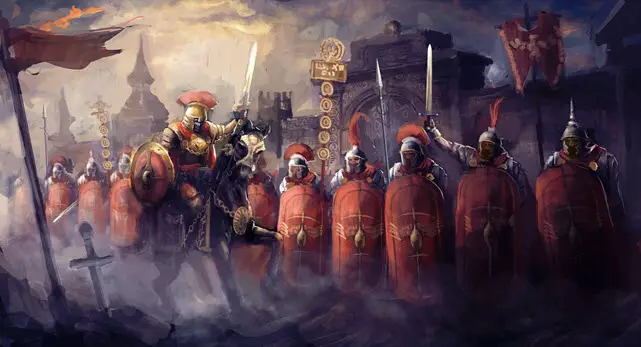
The young Roman Emperor, Alexander Severus, was murdered in 235 AD by his troops during a campaign along the Rhine.
It occurred at the worst possible time when Rome was already suffering a great deal at the barbarians’ hands. They were raiding and looting the Roman city, and under the pressure of a civil war, the Emperor succumbed to it.
Spanning more than 35 years, Rome saw her general and usurpers change frequently. As many as several dozen prominent figures rule Rome. Almost all of them were killed brutally in the warring zone with their rivals or assassinated by their men.
An illicit plague-infected Rome to top it all to which no human ingenuity availed any luck. Hence, the threat by surrounding Persians, Goths, and other forces increased manifold times.
At such a tumultuous time, the Empire disbanded into three states. Later, it was reunited, and the brutal troops were shown the exit gate. At the helm of this campaign was Emperor Aurelian.
However, the situation relapsed after his death. It was only in the late third century when Diocletian reformed and divided Rome into Eastern and Western factions, controlled by a tetrarchy of four leaders: a pair of Augusti (seniors) and Caesars (low-ranking).
1. The Civil Wars of the Tetrarchy
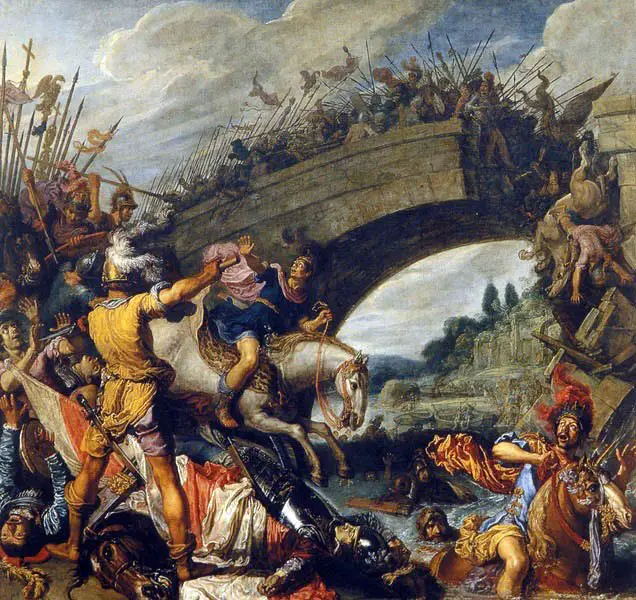
Source: Wikimedia Common
Employing multiple leaders was undeniably a means to invite civil war. With Diocletian’s tetrarchy in two factions, a civil war was imminent.
In 306 AD, Maxentius (son of Maxmilian) conspired to become the Emperor of Rome. Emperor Severus of the Western faction immediately retaliated but was executed by Maxentius by sweeping away his troops.
Several years had passed by, with Rome becoming a tangled web of cunning plots and intriguing conspiracies. So much so that about six men were contending the throne of Augustus at one point in time.
The schemes had translated into a war in 312 when Emperor Constantine occupied Italy through the Swiss alps and launched the Milvian Bridge’s battle. Maxentius was killed in the fight.
Constantine launched another war against Emperor Licinius. Gradually, he kicked all emperors from their positions and by 324, became the sole Emperor of Rome (both Eastern and Western parts).
It was another milestone for he converted to Christianity. The stability through his intervention was also not sustainable as Rome splintered into two pieces again, a few decades after his death.
Conclusion
The death of the Gracchi Brothers had already divided Rome into Populares and Optimates-the lower class and the noble aristocrats, respectively. Following the division, Rome’s first century continued to manifest the same dispute between activists of both types. Hence, Rome was churning between their wars and remained unstable.
The unconquerable leaders connived and fought within the Roman premises and eventually dismantled its Republican constitution. It is said that Rome collapsed under its weight, and I cannot agree more.
